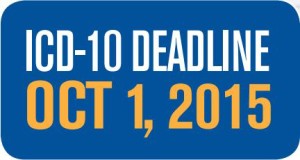By Rose O. Sherman, EdD, RN, FAAN
 If you work in healthcare then you probably already know that today is the day that hospitals and healthcare providers must begin using ICD-10 for coding. ICD stands for the International Classification of Diseases developed by the World Health Organization. It is used globally although in many countries, it is not part of their reimbursement system. ICD-10 represents the first major revision to diagnostic coding in more than 30 years. Although health systems have been gearing up for this day for more than 2 years, many are concerned about the ramifications that it could have in terms of provider productivity and denial of claims. The coding officially starts October 1st but it will be weeks before health systems know the impact in terms of reimbursement and effects on their revenue cycle.
If you work in healthcare then you probably already know that today is the day that hospitals and healthcare providers must begin using ICD-10 for coding. ICD stands for the International Classification of Diseases developed by the World Health Organization. It is used globally although in many countries, it is not part of their reimbursement system. ICD-10 represents the first major revision to diagnostic coding in more than 30 years. Although health systems have been gearing up for this day for more than 2 years, many are concerned about the ramifications that it could have in terms of provider productivity and denial of claims. The coding officially starts October 1st but it will be weeks before health systems know the impact in terms of reimbursement and effects on their revenue cycle.
What is Different about ICD-10?
ICD-10 increases the number of diagnostic and procedure codes from the 13,000 in the current ICD-9 system to 68,000 with the new system. The codes themselves change from 3-5 decimal points to 3-7 characters in an alpha-numeric combination. The goal in increasing the number of codes is to provide much more specificity about the patient problems and treatment by including specific terminology about location, laterality (side of body affected) severity, phase of the encounter (acute phase or subsequent encounter). The challenge for all clinical providers will be the level of detail that is needed in the patient’s record to support the coding that will be needed for full reimbursement. The coding of pressure ulcers is a good example. Under ICD-9, there were 9 codes for pressure ulcers. With ICD-10, there will be 125 available codes. The coders in health systems will be charged with the responsibility of analyzing clinical documentation and capturing as many of the codes as are appropriate for an individual patient.
What Will Change with Documentation?
Healthcare systems are already making changes to their electronic documentation systems to address the type of information that will be needed to properly code patient care although many now admit that they are far from finished with this effort. Patient injuries at home are a good example to illustrate the level of detail which needs to be captured in emergency department charting. Example: A 70 year old female falls at home in her kitchen after tripping over her cat. She complains of a possible concussion and a headache. All of the following information (and more) would need to be documented and coded:
- Type of Encounter (first visit for problem or subsequent visit)
- Did patient lose consciousness?
- Are complaints acute or chronic?
- Has she experienced relief from the headache with treatment or is it intractable?
- External cause of accident (there is a code for pet related injury)
- Activity at time of injury
- Location where injury occurred (there is a code for room in the house)
I spoke yesterday with a nurse practitioner working in an emergency room who had just finished her ICD-10 training. She told me that in most ERs today, providers are expected to spend no more than 30 minutes on a patient encounter. She reflected that everyone in training was very concerned about how this level of coding will slow down the process. She observed that there would have to be much more text entry (versus checklist) documentation of what is observed.
Here to Stay
There is no opting out of ICD-10. If you expect to be reimbursed for care beginning today, you must use it. If you code under the old system ICD-9, your reimbursement will be denied. There are many unknowns at this point including the potential impact on reimbursement although providers are What we do know is that more specificity will be needed in documentation including nursing documentation. This comes at a time when nurses are already expressing concern about increased workloads related to staffing shortages, regulatory and other performance requirements. It will no doubt be another challenge for nurse leaders but a necessary one to both improve care and lead to better communication across health systems.
Read to Lead
Centers for Medicare and Medicare Website on ICD-10
© emergingrnleader.com 2015


 LinkedIn
LinkedIn Instagram
Instagram